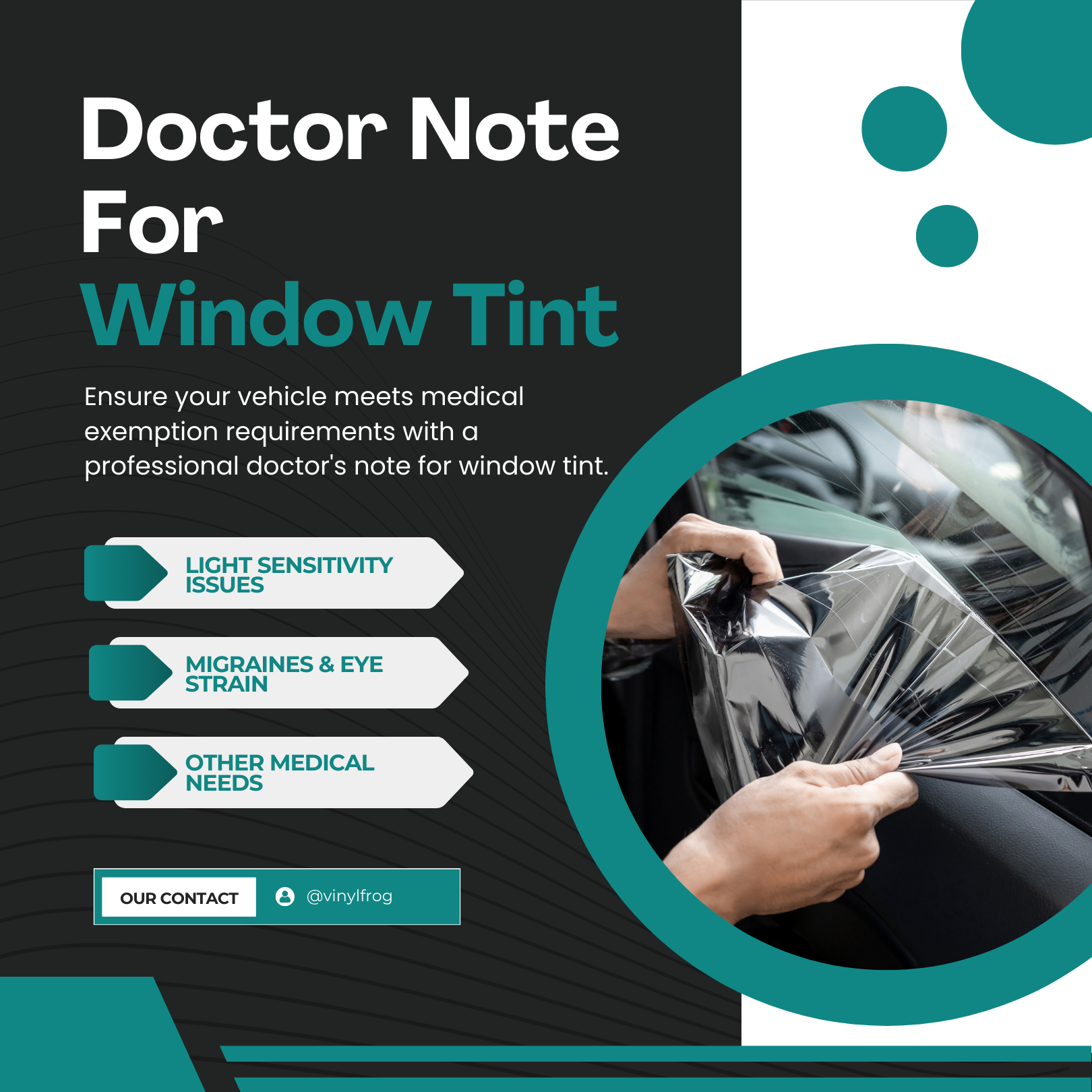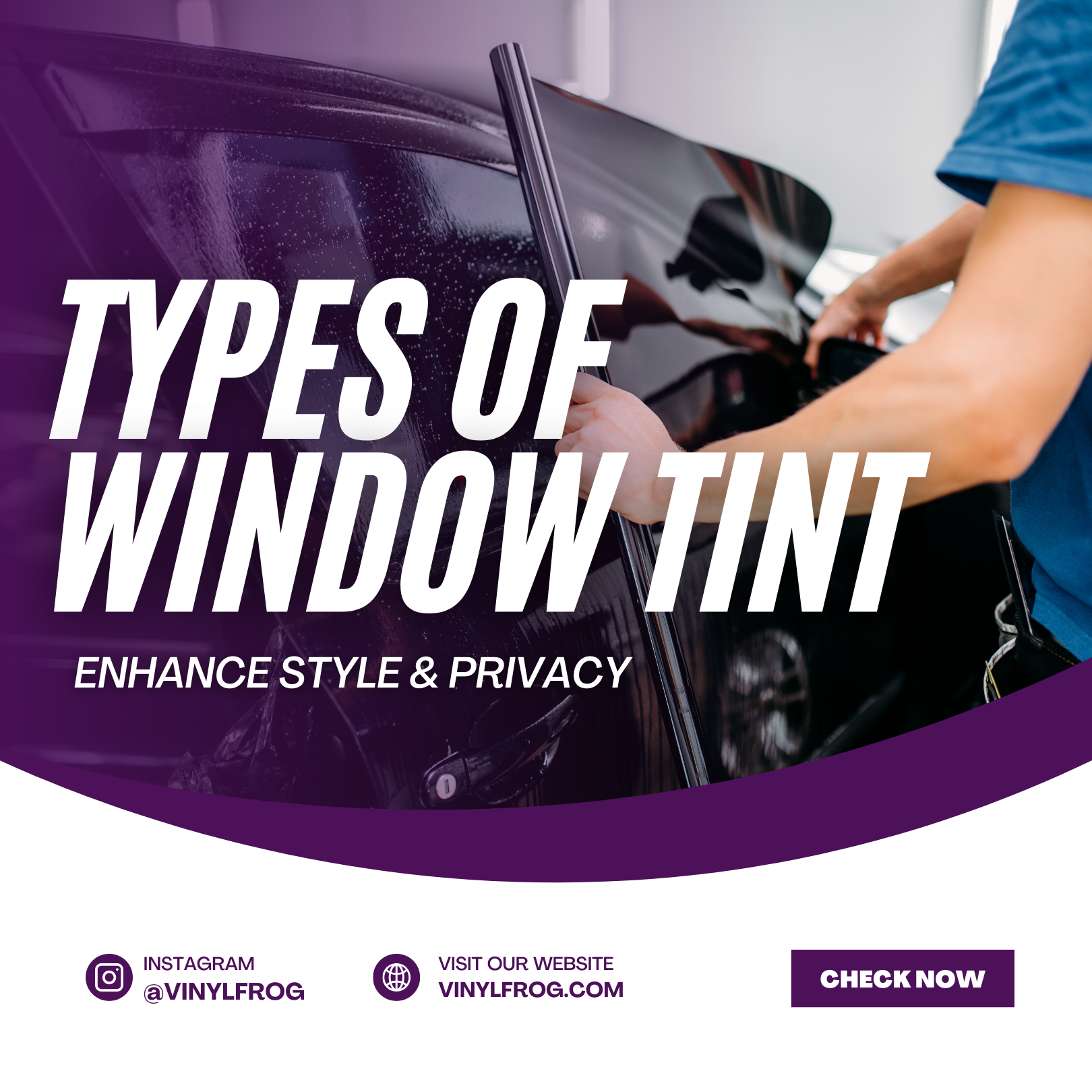Updated By Vinyl Frog On March 27, 2025
Virginia Window Tint Laws - Is 20% Tint Legal In Virginia?

Are you preparing for the hot and sweltering summers of Virginia? There is something you might not have considered putting on your holiday checklist: window tints! But before you install these on your vehicle, it is important to check the Virginia window tint laws.
You can get the windows of your vehicle tinted if you live in Virginia but there are restrictions on how dark they can be. In this article, we hope to clear up the confusion on Virginia’s tint laws and whether you can get a 20% VLT tint there or not.
Window tints are darkened films that go over the glass of your vehicle’s windows and ensure a cooler internal temperature. They also shield you against the scorching sun and block out harmful UV rays. One of the most popular tints is a 20% VLT tint that offers stellar protection, style, and safety. However, there are often certain states that have strict laws about window tints. Virginia is one of them.
Is Window Tint Legal In Virginia?
Yes, according to the tinting laws established in 1999, you can get a window tint on your vehicle in Virginia. However, there are certain restrictions on the percentage you can use and what part of the car you can use it on. The percentage being referred to here is Visible Light Transmission (VLT). This means the amount of light allowed to pass through the film.

For example, a 50% VLT tint allows half of the light to pass through while blocking the other half. The allowed percentage differs from state to state and from vehicle to vehicle as well. According to Virginia tint laws, your tint reflectivity must not exceed 20% and it cannot be red, yellow, or amber in color as it is illegal. Dual mirrors are also required for back tinted windows.
If you have installed window tints on your car in Virginia, you are required to apply stickers identifying the legal window tint. Make sure that your tint installer applies proper stickers showing your tint is legal in the state.
Virginia Tint Laws Regarding 20% VLT
Virginia state laws allow a 20% tint on rear and rear side windows in a multi purpose vehicle such as a SUV, truck or van. However, if you own a sedan, you cannot have 20% VLT tint applied on your vehicle’s windows, both front and rear, in Virginia. Having said that, a 20% tint does offer numerous benefits. It is darker than most, offering a decent amount of privacy while driving.
Safety is also an advantage of getting this tint as the darkened windows do not allow thieves to inspect valuables in the car. Moreover, since the film blocks a staggering 80% of visible light, the internal environment is cooler leading to reduced fuel usage as well. All this goes to show why this is one of the more popular tints.
Allowed Window Tint Darkness In Virginia For Vehicles
The Virginia state laws on tinting are specific and must be adhered to properly if you wish to avoid trouble. The specificities even extend to the type of car you drive as detailed below.
- Front windshield: The Virginia window tint law allows a non-reflective tint of 5 inches from the top that is above the manufacturer’s AS-1 line.
- Front side windows: It should permit 50% of light or more to pass through or
50% VLT (less than 20% reflectivity allowed). - Rear side windows: It should permit 35% of light or more to pass through or 35% VLT (less than 20% reflectivity allowed).
- Rear windshield: It should permit 35% of light or more to pass through or 35% VLT.
Virginia Window Tint Law Darkness For SUV, Trucks And Vans
- Front windshield: It can have a non-reflective tint of 5 inches on the top that is above the manufacturer’s AS-1 line.
- Front side windows: These should allow more than 50% of light to pass through or 50% VLT (20% reflectivity allowed).
- Backside windows: There is no such limitation for backside windows; you can use any darkness (20% reflectivity allowed).
- Rear windshield: There is no such limitation for backside windows; you can use any darkness.

Note: The strip of non-reflective window tint film on the front windshield makes driving safer by reducing the glare from the sun in your eyes. If there was no tint pre-installed at the factory, you should get it applied as it is allowed according to Virginia tint laws.
Medical Exemptions According To Virginia Tint Laws
There are exemptions to the tinting laws stated above. People with serious medical conditions can have darker window tint on their vehicles than what is normally allowed by law. The exemption applies to the front side windows, which are typically required to allow at least 50% of light to pass through.
To qualify for the medical exemption in Virginia, a licensed physician must provide a written statement explaining the medical condition and recommending the use of darker window tint. The statement must be carried in the vehicle at all times and presented to law enforcement upon request.
Acceptable medical conditions for the exemption include conditions that require protection from sunlight or bright lights, such as lupus, porphyria, xeroderma pigmentosum, cockayne syndrome, albinism, bloom syndrome and severe allergic reactions to sunlight. Other conditions that may qualify include chronic migraines, epilepsy, and other conditions that cause sensitivity to light.
It is important to note that the medical exemption only applies to the front side windows, and the rear side and rear windows must still comply with Virginia's tinting laws. After medical authorization, you are allowed to tint the following:

- Front windshield: The Virginia window tint law allows 35% non-reflective tint of 5 inches from the top that is above the manufacturer’s AS-1 line. You can also get 70% VLT tint on the entire windshield.
- Front side windows: You can get a tint that permits 35% of light or more to pass through (less than 20% reflectivity allowed).
- Rear side windows: You can get a tint that permits 35% of light or more to pass through (less than 20% reflectivity allowed).
- Rear windshield: You can get a tint that permits 35% of light or more to pass through (less than 20% reflectivity allowed).
More About Window Tint Laws In Virginia
In addition to the medical exemption, Virginia has several other laws, rules, and regulations regarding window tinting.
- If any window is tinted, dual side mirrors are required by law.
- Certain colors of window tint are also prohibited, including red, yellow, and amber.
- The state allows for a 7% variance in tint, meaning that the actual level of tint can be 7% different from what is stated on the tinting certificate.
- Unlike some states, film manufacturers in Virginia do not need to certify the film they sell.
- Moreover, violations of Virginia's tinting laws can result in penalties, including a Class 3 misdemeanor for the first offense and a Class 2 misdemeanor for subsequent offenses. A class 3 misdemeanor includes a monetary fine of up to $500.
- For a Class 2 misdemeanor, you can be sentenced to up to six months in jail or a fine of up to $1000. In the most serious cases, you can get both. Please note that illegal window tint is not worth such serious penalties, so avoid violation of window tint laws in Virginia.
It is important for Virginia residents to be aware of these laws and regulations to avoid potential legal trouble.
Different Kinds Of Window Tints
Window tints come in a variety of types, each with their own pros and cons. While state laws permit all of them, here is a detailed list to help you make an informed decision.
Dyed Tints
This type is relatively cheaper and readily available as well. It consists of a film that is layered with coats of a dye to give it a darker look. It does a decent job of protecting the vehicle from the sun and offers privacy. However, it has a tendency to fade with time and needs frequent replacement.

Metallized Tints
These films are made from metal particles that reflect the light it encounters. This also safeguards your windows from shattering on impact and are scratch proof due to the sturdy metal used. However, while this tint is more effective, it is also more expensive and messes with GPS and radio signals.
Ceramic Tints
To counter the problem of interference with signals, you may use a ceramic tint. This film uses nanotechnology and miniscule ceramic particles that block out infrared as well. While this may be the most expensive tint, it is highly functional as it blocks out UV rays, reduces glare and is insulating.

Hybrid Tints
This tint combines the benefits of both dyed and metallized tints to provide a stronger barrier against the sun. As a result, the durability of the product is also increased along with the price tag. The issue with signal interference is also present.
Carbon Tints
This window tint is similar to metalized tint but does not contain any metallic particles. It consists of carbon that is reflective and offers a sleek matte finish to your windows. However, it is more expensive than other types of tint, but it is very effective at blocking out heat and UV rays.
Frequently Asked Questions
Know The Virginia Window Tint Laws
Investing in window tints can open a door of advantages not only for your vehicle but for you as well. Now that you are aware of the legality of tints in Virginia, you can head over to Vinyl Frog and get one with the right VLT according to the law. We provide a wide range of premium quality films suitable for all vehicles. Check out our catalog on our website!








